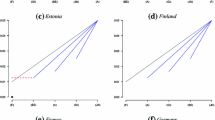Summary
The “Scandinavian Model” divides the economy of a small country into two sectors. The exposed sector produces commodities traded on the world market, the sheltered sector produces commodities not traded externally. The E-sector is a price taker, while the price level in the S-sector is set by firms of this sectors. This model developed byO. Aukrust andG. Edgren, K.O. Faxén, C.O. Odhner is generalized by introducing a Phillips relation into the E-sector. The rate of inflation of a small economy thus is influenced by three components: imported inflation, a structural component (due to the Aukrust-EFO-model) and an excess demand component (measured by the rate of unemployment). The model is estimated with OLS and 3SLS (ordinary respectively three stage least squares). The results show that the rate of inflation in Austria during the period 1960–1974 can be fairly well explained by “Phillips curve augmented” Aukrust-EFO-model.
In a final chapter the results of applying the same model to Austria and Sweden are discussed by comparing the respective estimates.
Similar content being viewed by others
Literaturverzeichnis
O.Aukrust: Prim. I: A Model of the Price and Income Distribution Mechanism of an Open Economy. Artikler fra Statistik Sentralbyra, No. 35, Oslo 1970.
G.Edgren-K.O.Faxén-C.E.Odhner: Wages, Growth and the Distribution of Income. Swedish Journal of Economics, 1969.
G.Edgren-K.O.Faxén-C.O.Odhner: Wage Formation and the Economy. London 1973.
G.Maynard-W.vanRijckeghem: A World of Inflation, Chapt. 1 und Chapt. 8. London 1976.
G.Maynard-W.van Rijckeghem: Why Inflation Rates Differ: A Critical Examination of the Structural Hypothese. In:H. Frisch (ed.): Inflation in Small Countries, Lecture Notes in Economics and Mathematical Systems, Vol. 119. Berlin-Heidelberg-New York 1976.
W.Branson-J.Myhrman: Inflation in Open Economies, Supply-Determined versus Demand-Determined Models. In:H.Frisch (ed.): Inflation in Small Countries, Lecture Notes in Economics and Mathematical Systems, Vol. 119. Berlin-Heidelberg-New York 1976.
L.Calmfors: Swedish Inflation and International Price Influences. Institute for International Economic Studies, Seminar Paper No. 45, Stockholm 1975.
R.L.Basman: Econometrica, S. 824, October 1962.
A.van Poeck: The Scandinavian Model of Inflation and the Belgian Economy. Tijdschrift voor Economie en Management, Vol. 20(4), 1975.
K.Rose: Theorie der Außenwirtschaft, S. 106 ff. Berlin 1970.
H.Johnson: The Monetary Approach to Balance of Payments Theory. In: Further Essays in Monetary Economics. London 1972.
F.Machlup: Another View of Cost-push and Demand-pull Inflation. Review of Economics and Statistics, Vol. 42, 1960. Reproduced in:R.J. Ball-P.Doyle (eds.): Inflation. 1969.
D.E.W.Laidler-J.M.Parkin: Inflation: A Survey. The Economic Journal, Vol. 85, December 1975.
Rights and permissions
About this article
Cite this article
Frisch, H. Eine Verallgemeinerung des skandinavischen Modells der Inflation. Empirica 3, 197–218 (1976). https://doi.org/10.1007/BF00924966
Issue Date:
DOI: https://doi.org/10.1007/BF00924966




